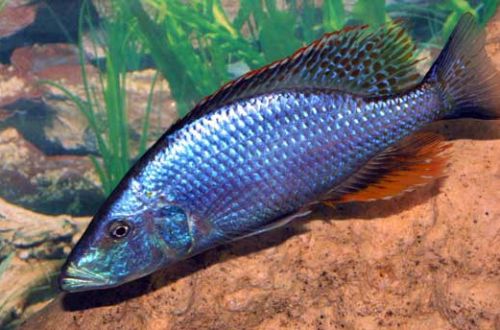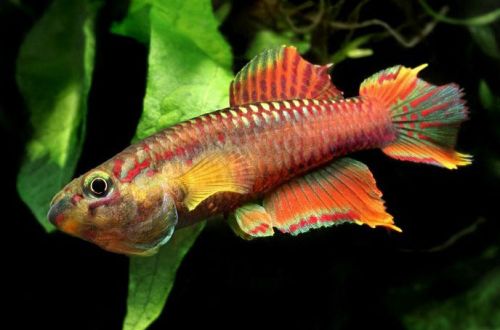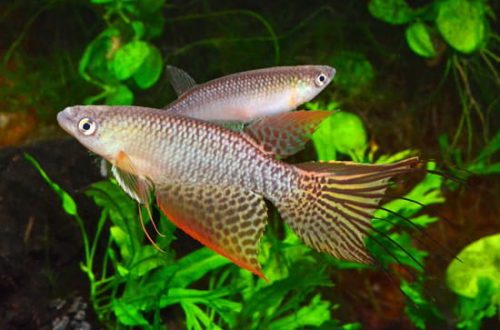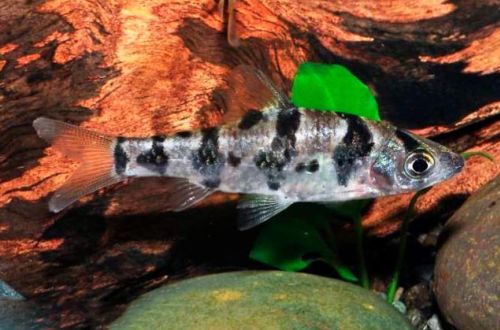
Dimidochromis
Dimidochromis, scientific name Dimidiochromis compressiceps, belongs to the Cichlidae family. One of the most colorful predators, the body color is dominated by blue and orange hues. It has explosive speed and powerful jaws that are a threat to any small fish.

Despite its predatory disposition, it is very peaceful towards species of a similar or slightly smaller size, therefore it is often used in large biotope aquariums that recreate a certain natural area, in this case the underwater world of Lake Malawi. At home, it is rarely kept due to its small size.
Requirements and conditions:
- The volume of the aquarium – from 470 liters.
- Temperature – 23-30°C
- pH value – 7.0-8.0
- Water hardness – medium hardness (10–18 dH)
- Substrate type – sand with rocks
- Lighting – moderate
- Brackish water – allowed at a concentration of 1,0002
- Water movement is weak
- Size – up to 25 cm.
- Nutrition – high-protein food
- Life expectancy – up to 10 years.
Habitat
Endemic to Lake Malawi in Africa, found in many areas of the lake. It lives mainly in shallow water in open areas with a sandy bottom and areas of thickets of a plant of the genus Vallisneria (Vallisneria), sometimes it is seen in rocky areas. Prefers calm waters with a weak current. In nature, they hunt small fish.
Description

A fairly large fish, an adult reaches 25 cm. The body is strongly flattened from the sides, which makes Dimidochromis the flattest among the cichlids of this lake. The back has a rounded outline, while the stomach is almost even. The dorsal and anal fins are shifted closer to the tail. The fish has powerful jaws studded with numerous sharp teeth.
The coloration of males resembles metallic blue, sometimes with a greenish tinge. The fins are orange with characteristic colored dots. Females and juveniles are mostly silver in color.
Food
Any small fish will certainly become the prey of this formidable predator. However, in a home aquarium, it is not necessary to feed exclusively with live food. It is allowed to feed fish meat, shrimp, shellfish, mussels. It is necessary to serve some amount of vegetation, in the form of pieces of green vegetables. Juveniles can be fed with bloodworms, earthworms.
Maintenance and care
Such a large fish will need a tank of about 500 liters. Such volumes are necessary for the fish to have a place to accelerate, in cramped conditions Dimidochromis quickly loses its tone. The design is quite simple, a substrate of sand or fine gravel with areas of small thickets of the Vallisneria plant, which are recommended to be located in any one zone, and not everywhere throughout the area.
The quality and composition of the water is of decisive importance. Acceptable conditions are the following parameters: pH – slightly alkaline, dH – medium hardness. More details about the parameters and ways to change them in the section “Hydrochemical composition of water”.
Big fish produce a lot of waste, which, coupled with a meat diet, leads to a rapid accumulation of dirt, so cleaning the soil with a siphon and updating the water by 20-50% should be done weekly. The volume of water to be replaced depends on the size of the tank, the number of fish and the performance of the filtration system. The more efficient the filter, the less water will need to be renewed. Other minimum required equipment includes heating, aeration and lighting systems.
Behavior
Moderately aggressive behavior, does not attack other fish of similar size, with the exception of members of its own species – deadly skirmishes occur between males. Optimal content in a harem, where there are several females per male.
It is worth remembering that any small fish automatically becomes an object of hunting.
Breeding / Reproduction
There are examples of successful cultivation of Dimidochromis in the artificial environment. Females prefer to lay their eggs on some hard, flat surface, such as a flat stone. Then they are immediately placed in the mouth – this is an evolutionary defense mechanism inherent in most cichlids. The entire incubation period (21–28 days) is spent in the female’s mouth. All this time, food intake is impossible, so if feeding before spawning was not regular or insufficient, she may release eggs ahead of time.
No less interesting is the process of fertilization. Each male on the anal fin has a characteristic pattern of several bright dots, resembling eggs in shape and color. The female, mistakenly perceiving the drawing for real eggs, tries to pick them up, at this moment the male releases seminal fluid and the process of fertilization takes place.
Fish diseases
A characteristic disease for this and other cichlid species is “Bloating Malawi”. The main reasons lie in inappropriate conditions of detention and unbalanced nutrition. So, both a change in water parameters and the absence of herbal supplements in the diet can provoke a disease. Read more about symptoms and treatments in the Aquarium Fish Diseases section.
Features
- Predatory view
- Harem content
- The need for a large aquarium





